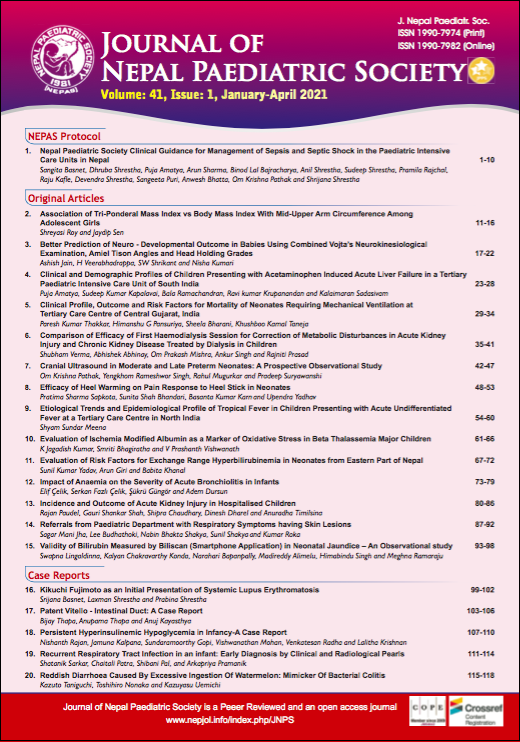Clinical and Demographic Profiles of Children Presenting with Acetaminophen Induced Acute Liver Failure in a Tertiary Paediatric Intensive Care Unit of South India
DOI:
https://doi.org/10.3126/jnps.v41i1.30616Keywords:
Acetaminophen (APAP), Acute Liver Failure (ALF), ParacetamolAbstract
Introduction: Acetaminophen (APAP) is the most widely used over-the-counter antipyretic and analgesic medicine in children. Although hepatic failure and death is rare in paediatric population, it is one of the most important and dangerous presentation of acetaminophen induced toxicity in children. There is very sparse data regarding APAP induced paediatric acute liver failure in our settings, hence this study was done to know the clinical and demographic profiles as well as outcome of children with APAP induced acute liver failure.
Methods: This was a retrospective study done in children aged 0 - 18 years admitted with the diagnosis of acetaminophen induced acute liver failure in a tertiary paediatric intensive care unit of South India from January 2014 to December 2018. The clinical, demographic profiles and outcome of these patients were reviewed and analysed.
Results: A total of 26 children had acetaminophen induced acute liver failure. Out of 26 patients, 53.8% were males and 46.1% were females. Among these, 24 (92.3%) survived and two (7.7%) died. The average dose of acetaminophen ingested was 168.5 mg/ kg/d. The mean serum acetaminophen level was 52.3 mg/dl. The presence of low pH, hypotension and international normalised ratio (INR) value of > 4 showed bad outcome in children with acetaminophen induced acute liver failure.
Conclusion: Paracetamol induced acute liver failure is rare but fatal presentation in children. Children with acidosis, shock and INR value of > 4 had poor prognosis. Hence, judicious use of different preparations as well as counselling to parents regarding use of appropriate doses in children should be done while prescribing this medicine.
Downloads
Downloads
Published
How to Cite
Issue
Section
License
Authors who publish with this journal agree to the following terms:
Authors retain copyright and grant the journal right of first publication with the work simultaneously licensed under a Creative Commons Attribution License that allows others to share the work with an acknowledgement of the work's authorship and initial publication in this journal.
Authors are able to enter into separate, additional contractual arrangements for the non-exclusive distribution of the journal's published version of the work (e.g., post it to an institutional repository or publish it in a book), with an acknowledgement of its initial publication in this journal.
Authors are permitted and encouraged to post their work online (e.g., in institutional repositories or on their website) prior to and during the submission process, as it can lead to productive exchanges, as well as earlier and greater citation of published work (See The Effect of Open Access).



